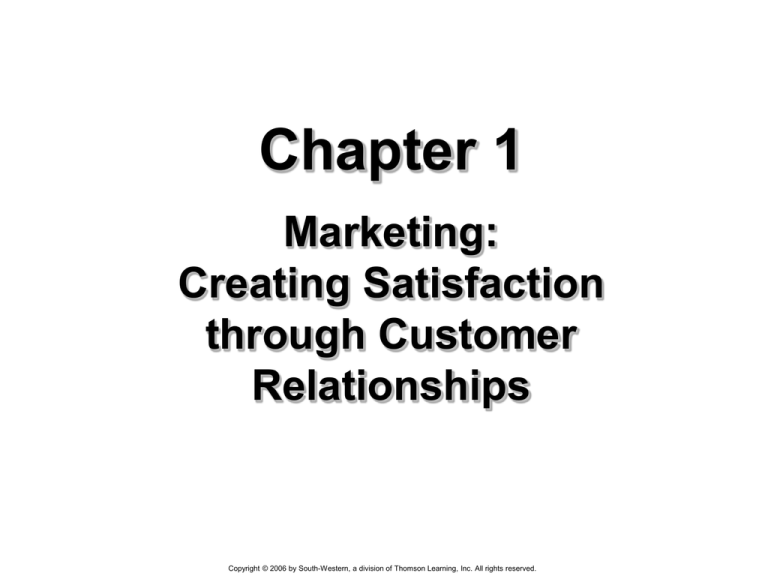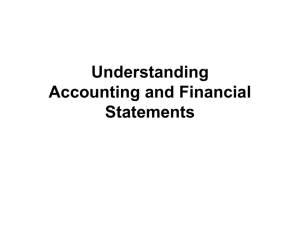
Chapter 1
Marketing:
Creating Satisfaction
through Customer
Relationships
Copyright © 2006 by South-Western, a division of Thomson Learning, Inc. All rights reserved.
Chapter Objectives
1. Explain how marketing creates utility through the
exchange process.
2. Contrast marketing activities during the four eras in the
history of marketing.
3. Define the marketing concept and its relationship to
marketing myopia.
4. Describe the characteristics of not-for-profit marketing.
5. Describe the five types of nontraditional marketing.
6. Outline the changes in the marketing environment due
to technology.
7. Explain the shift from transaction-based marketing to
relationship marketing.
8. Identify the universal functions of marketing.
9. Demonstrate the relationship between ethical business
practices and marketplace success.
Copyright © 2006 by South-Western, a division of Thomson Learning, Inc. All rights reserved.
1-2
What is Marketing
Marketing creates utility through the
exchange process
Utility: Want-satisfying power of a
good or service
Form utility
Time utility
Place utility
Ownership utility
Copyright © 2006 by South-Western, a division of Thomson Learning, Inc. All rights reserved.
1-3
How to Create Customers
Identifying customer needs
Designing goods and services that meet
those needs
Communicating information about those
goods and services to prospective buyers
Making the goods or services available at
times and places that meet customers’ needs
Pricing goods and services to reflect costs,
competition, and customers’ ability to buy
Providing for the necessary service and
follow-up to ensure customer satisfaction after
the purchase
Copyright © 2006 by South-Western, a division of Thomson Learning, Inc. All rights reserved.
1-4
A Definition of Marketing
Marketing: the process of planning and
executing the conception, pricing,
promotion, and distribution of ideas,
goods, services, organizations, and events
to create and maintain relationships that
will satisfy individual and organizational
objectives.
Copyright © 2006 by South-Western, a division of Thomson Learning, Inc. All rights reserved.
1-5
American Marketing Association’s new
official definition of marketing released
August 2004:
Marketing is an organizational function
and a set of processes for creating,
communicating and delivering value to
customers and for managing customer
relationships in ways that benefit the
organization and its stakeholders.
Copyright © 2006 by South-Western, a division of Thomson Learning, Inc. All rights reserved.
1-6
Both definitions also identify the
marketing variables that together
provide customer satisfaction
Product
Price
Promotion
Distribution
Copyright © 2006 by South-Western, a division of Thomson Learning, Inc. All rights reserved.
1-7
Four Eras in the History of Marketing
Production Era
Prior to 1920s
Business success often defined solely in
terms of production victories
Sales Era
Prior to 1950s
Customers resist nonessential goods and
services
Personal selling and advertising’s task is to
convince them to buy
Copyright © 2006 by South-Western, a division of Thomson Learning, Inc. All rights reserved.
1-8
Marketing Era
Since 1950s Marketing Concept Emerges
Satisfying customer needs
Emergence of the Marketing Concept
Shift from seller’s to buyer’s market
Company–wide consumer orientation
Objective of achieving long–run success
Copyright © 2006 by South-Western, a division of Thomson Learning, Inc. All rights reserved.
1-9
Relationship Era
Began in 1990s
Carried customer orientation even further
Focuses on establishing and maintaining
relationships with both customers and
suppliers
Involves long–term, value–added
relationships
Copyright © 2006 by South-Western, a division of Thomson Learning, Inc. All rights reserved.
1-10
Converting Needs to Wants
The need for a vacation
becomes a desire to take
Caribbean Holiday
The need for fitness becomes a
desire for exercise classes
Brooks Focuses on the Benefit of
Comfort in Marketing Its Shoes
Copyright © 2006 by South-Western, a division of Thomson Learning, Inc. All rights reserved.
1-11
Avoiding Marketing Myopia
Marketing Myopia is management’s failure
to recognize the scope of its business.
To avoid marketing myopia, companies
must broadly define organizational goals
toward consumer needs
Focus on benefits
Copyright © 2006 by South-Western, a division of Thomson Learning, Inc. All rights reserved.
1-12
Extending the Traditional Boundaries
of Marketing
Marketing in not-for-profit organizations
Characteristics of not-for-profit marketing
Lack of a bottom line
Often market to multiple publics
May market both goods and services
Customer or service user may wield less
control over the organizations destiny than
customers of profits seeking firms
Resource contributor may interfere with the
marketing program
Copyright © 2006 by South-Western, a division of Thomson Learning, Inc. All rights reserved.
1-13
Nontraditional Marketing
Person Marketing
Place Marketing
Cause Marketing
Event Marketing
Organization Marketing
Copyright © 2006 by South-Western, a division of Thomson Learning, Inc. All rights reserved.
1-14
Creativity and Critical Thinking
Challenges presented by today’s complex
and technologically sophisticated marketing
environment require critical-thinking skills
and creativity from marketing professionals
Critical Thinking refers to the process of
determining the authenticity, accuracy, and
worth of information, knowledge, claims and
arguments
Creativity helps to develop novel solutions to
perceived marketing problems
Copyright © 2006 by South-Western, a division of Thomson Learning, Inc. All rights reserved.
1-15
The Technology Revolution
in Marketing
Technology: Application to business of
knowledge based on scientific discoveries,
inventions, and innovations
Interactive marketing refers to buyer-seller
communications in which the customer
controls the amount and type of information
received from a marketer
Copyright © 2006 by South-Western, a division of Thomson Learning, Inc. All rights reserved.
1-16
The Internet
The World Wide Web
Broadband technology is extremely high
speed, always-on Internet connection
Wireless Internet connections for laptops
and PDA’s
Interactive Television Service (iTV)
Copyright © 2006 by South-Western, a division of Thomson Learning, Inc. All rights reserved.
1-17
How Marketers Use
the Web
Interactive
brochures
Online newsletters
Virtual storefronts
Information
clearinghouses
Customer service
tools
Copyright © 2006 by South-Western, a division of Thomson Learning, Inc. All rights reserved.
1-18
From Transaction-Based
Marketing to Relationship
Marketing
Transaction–based marketing
(Simple exchanges)
Relationship marketing
Lifetime value of a customer
Converting new customers to
advocates
Copyright © 2006 by South-Western, a division of Thomson Learning, Inc. All rights reserved.
1-19
One-to-One Marketing
Customized marketing program designed
to build long-term relationships with
individual customers.
Identifying a firm’s best customers and
increasing their loyalty.
Developing Partnerships and
Strategic Alliances
Create competitive advantages
Copyright © 2006 by South-Western, a division of Thomson Learning, Inc. All rights reserved.
1-20
Costs and Functions of Marketing
1. Buying: Ensuring that product offerings are available in
sufficient quantities
2. Selling: Using advertising, personal selling, & sales promotion
to match products to customer needs
3. Transporting: moving products from production to convenient
purchasing locations
4. Storing: warehousing products until sales
5. Standardizing & Grading: Ensuring products meet quality &
quantity standards
6. Financing: Providing credit for channel members
7. Risk Taking: Dealing with uncertainty about future customer
purchases
8. Securing Marketing Info.: Collecting information about
consumers, competitors, & channel members for using in
marketing decisions.
Copyright © 2006 by South-Western, a division of Thomson Learning, Inc. All rights reserved.
1-21
Ethics and Social Responsibility:
Doing Well by Doing Good
Increased Employee Loyalty
Better Public Image
Market Place Success
Improved Financial Performance
Copyright © 2006 by South-Western, a division of Thomson Learning, Inc. All rights reserved.
1-22







